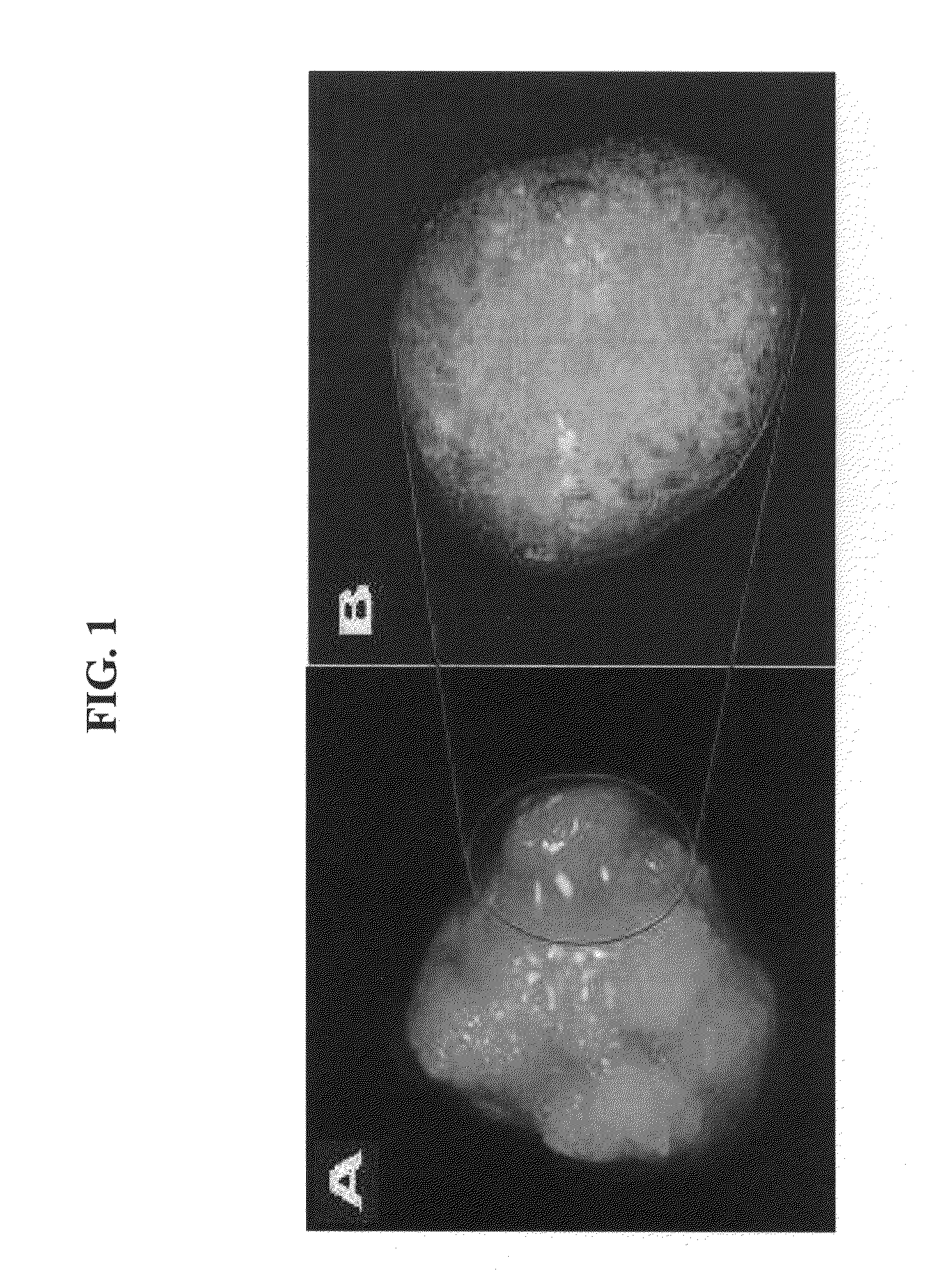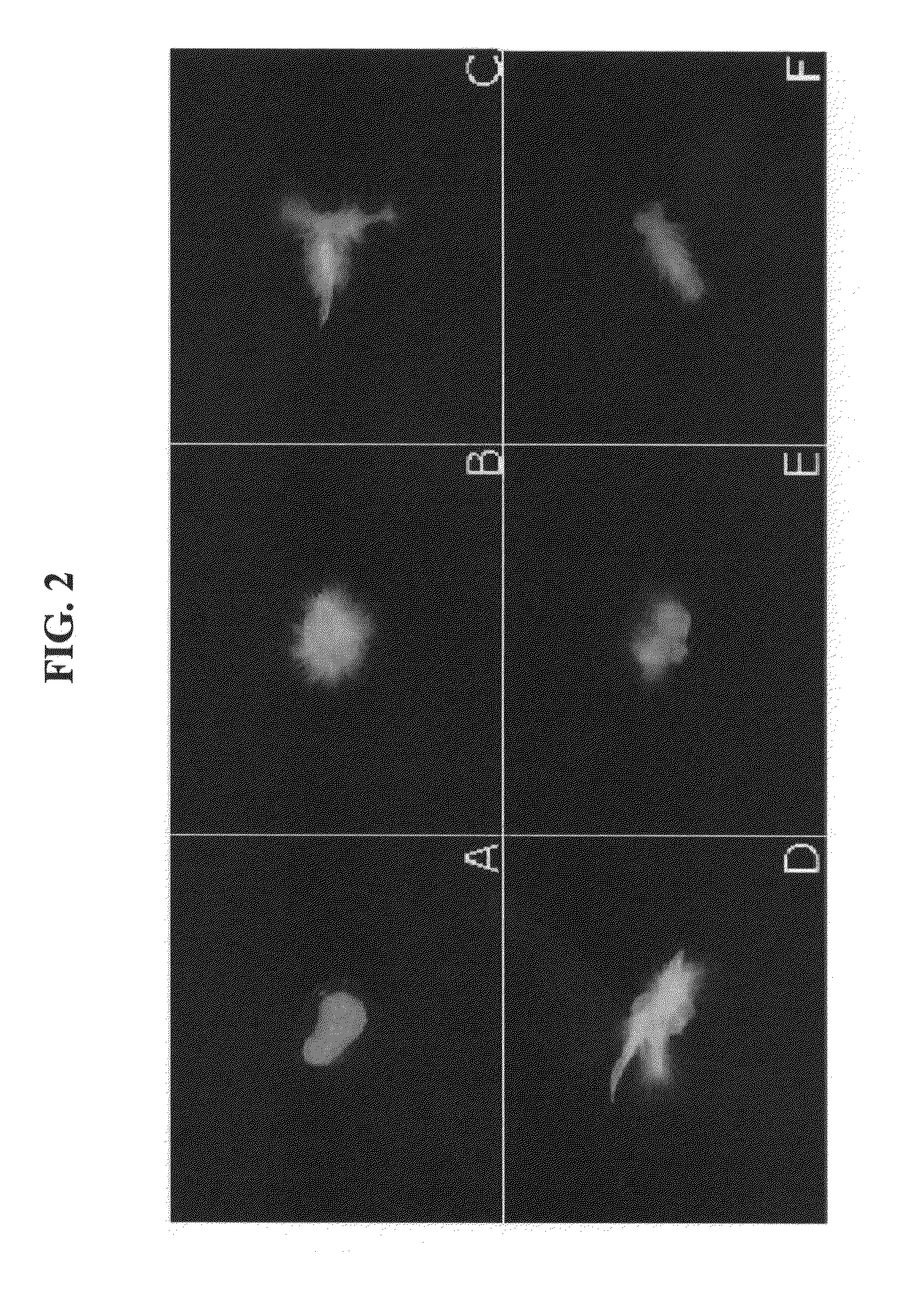Plant stem cell line derived from quiescent center and method for isolating the same
a plant stem cell and quiescent center technology, applied in the field of plant stem cell line derived from quiescent center, can solve the problems of difficult development of physiologically active substances into drugs, slow growth rate of plants, limited contents of physiologically active substances in plants, etc., and achieve the effect of stable cultur
- Summary
- Abstract
- Description
- Claims
- Application Information
AI Technical Summary
Benefits of technology
Problems solved by technology
Method used
Image
Examples
example 1
Isolation of Cell Line Derived from Quiescent Center of Rice Plant
1-1: Preparation of Plant Material
[0058]Rice seeds were peeled, surface-sterilized with 70% ethanol for 1 minute, soaked in 2% sodium hypochlorite solution for 1 hour, and then washed once or twice with sterilized water. The washed seeds were sufficiently washed with sterilized water for 30 minutes, and then dried to completely remove moisture.
[0059]The dried seeds were seeded in N6 medium (CHU MEDIUM, Chu C. C., Proc. Symp. Plant Tissue Cult., Peking, 43, 1978) and cultured at 25° C. for 5 days, such that they were germinated. The composition of the N6 medium is shown in Table 1 below.
TABLE 1CompositionConcentrationMacroelementsCaCl2•2H2O1.13mM125.33mg / LKH2PO42.94mM400.00mg / LKNO327.99mM2830.00mg / LMgSO4•7H2O0.75mM90.27mg / L(NH4)2SO43.50mM463.00mg / LMicroelementsFeNaEDTA0.10mM36.70mg / LH3BO325.88μM1.60mg / LKI4.81μM0.80mg / LMnSO4•4H2O19.70μM3.33mg / LZnSO4•7H2O5.22μM1.50mg / LVitaminsGlycine26.64μM2.00mg / LThiamine-HCl2.96μM1.00m...
example 2
Isolation of Cell Line Derived from Quiescent Center of Maize Plant
[0068]Maize seeds were germinated in the same manner as in Example 1-1, and from the root of the germinated plant, the quiescent center-containing explant was collected. Then, the explant was cultured in media containing each of 2,4-D, CPA, IAA, IBA, NAA and Picloram, in the same manner as in Example 1-2, and whether the quiescent center-derived cell line was induced was observed.
[0069]As a result, as shown in FIG. 4, when the quiescent center-containing explant of the maize plant was cultured, the induction of the cell line was observed in the 2,4-D-containing media in the same manner as the case in which the quiescent center-containing root explant of the rice plant was cultured. However, in the case of auxins other than 2,4-D, cells were not induced after the inoculation of the explant, and adventitious roots developed in the explant. In FIG. 4, “A” is a tissue cultured in 2,4-D-containing media, “B” is a tissue c...
example 3
Observation of Characteristics of Cell Line Derived from Quiescent Center of Rice Plant
3-1: Observation of Morphological Change During Long-Term Culture
[0071]The quiescent center-derived cell line isolated in Example 1 was inoculated into a culture medium having the same composition as in the cell line induction medium of Example 1-2, that is, N6 media containing 2 mg / L of 2,4-D, and was allowed to proliferate. After 4 weeks and 16 weeks of cell growth, the proliferated quiescent center cells were observed. Meanwhile, as control groups, cell lines derived from root tissues other than the quiescent center were allowed to proliferate in the same manner as described above, and then the morphological changes of the cells were observed.
[0072]As a result, as shown in FIG. 5, morphological changes were observed in the root tissue-derived cell lines after 4 weeks (FIG. 5A) and 16 weeks (photographs other than FIG. 5A) of culture. After 16 weeks of culture, several local differentiations wer...
PUM
| Property | Measurement | Unit |
|---|---|---|
| thickness | aaaaa | aaaaa |
| size | aaaaa | aaaaa |
| concentration | aaaaa | aaaaa |
Abstract
Description
Claims
Application Information
 Login to View More
Login to View More - R&D
- Intellectual Property
- Life Sciences
- Materials
- Tech Scout
- Unparalleled Data Quality
- Higher Quality Content
- 60% Fewer Hallucinations
Browse by: Latest US Patents, China's latest patents, Technical Efficacy Thesaurus, Application Domain, Technology Topic, Popular Technical Reports.
© 2025 PatSnap. All rights reserved.Legal|Privacy policy|Modern Slavery Act Transparency Statement|Sitemap|About US| Contact US: help@patsnap.com



